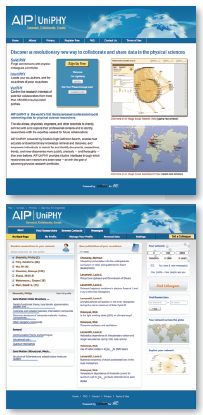Physicists get new research network
Siân Harris finds out about a new social network to help physicists work together and share information

The very different research fields of biomedicine and physics have some curious similarities. Both have long-established and well-used preprint repositories. Both see great support for open-access publishing. And both have large, international, research collaborations like the Human Genome Project and the new Large Hadron Collider.
All of these similarities reflect the way that researchers in these fields like to work together and share information. This collaborative behaviour may be key to the success of a new similarity between the two research fields: both now have pre-populated research networks based on technology by Collexis.
Last year, Collexis launched its first large research network, BiomedExperts. This boasted 1.5 million pre-loaded profiles in biomedicine at launch, all derived from information in PubMed. Having so much pre-loaded information meant that, even if nobody did anything with their own profiles, researchers could still visualise and track research and collaboration trends and derive new ideas about people to work with or things to focus on.
Tim Ingoldsby and colleagues at the American Institute of Physics (AIP) were struck by the potential of this tool when they saw it demonstrated at a show earlier this year, so they began to work with Collexis on a similar tool for physicists.
‘I was excited about the possibilities to do the same thing with physics, and we have a resource that is similar to the information underlying BiomedExperts,’ said Ingoldsby, who is director of strategic initiatives and publisher relations at AIP.
‘We see professional social networking as very much part of the future for society publishers,’ he added. ‘One of the things we are very sensitive to is that most of our advice is from senior researchers, and so we see this as a way of connecting with younger researchers.’
The result of AIP’s work with Collexis, which was unveiled to coincide with the ALPSP annual conference, from 9 to 11 September, is called UniPHY. AIP has invested more than US$1 million in this free service for the physics community. As with the launch of BiomedExperts, AIP UniPHY was pre-populated with information from AIP’s databases so it already has an extensive network of research links and patterns. At launch, the network had more than 180,000 profiles of researchers and around one million connections, showing who researchers have published with and in which areas and parts of the world.
Anyone can join the network but, to have a profile, they have to have published in a physics-related journal. Release 1 of UniPHY allows users to receive alerts about the latest papers from their closest connections. They can make new connections and communicate with each other. Users can also bookmark people whose research they want to follow without being in their network.
They can search for researchers too. Once users have found a researcher they are interested in, they can click on that person to see their network, those people the researcher has published with and how many papers they have in common. They can also pan out to see who a person’s collaborators have collaborated with.
Users of UniPHY can search by research area too. The underlying AIP database was indexed as the papers were published. In addition, the Collexis technology goes through the papers and generates further keywords. The service also includes a thesaurus, which suggests alternatives to search terms, and users can browse for key words too. The results of this type of search can be displayed in various ways. One example is a map of where the research was carried out, with the size of the squares on the map reflecting the numbers of papers published in that particular area. The Collexis technology also uses the keywords in articles to create scientific context and suggest other articles and authors in the same research area, in much the same way that services like Amazon offer other books, for example, that users might be interested in.
Once users of UniPHY have found articles that they are interested in, they can link from the service to the article abstract and references. They can also link to the full text of the article, wherever it may be, using CrossRef.
A second release is expected to follow by the end of this year. This promises to include the facility for researchers to upload their photographs and add more to their personal profiles. There will also be more pre-computed information, such as data about research grants that people have been given.
Soon after the initial launch, AIP also hopes to begin working with other physics societies to grow the resource.
Then the question is only whether physicists will actually use this. Ingoldsby is optimistic about this: ‘I hope it will have even faster uptake than in biomedicine. After all, physicists invented the web and we think physicists will jump to the opportunity to use this service. The power of a pre-populated network is a no-brainer,’ he said.






